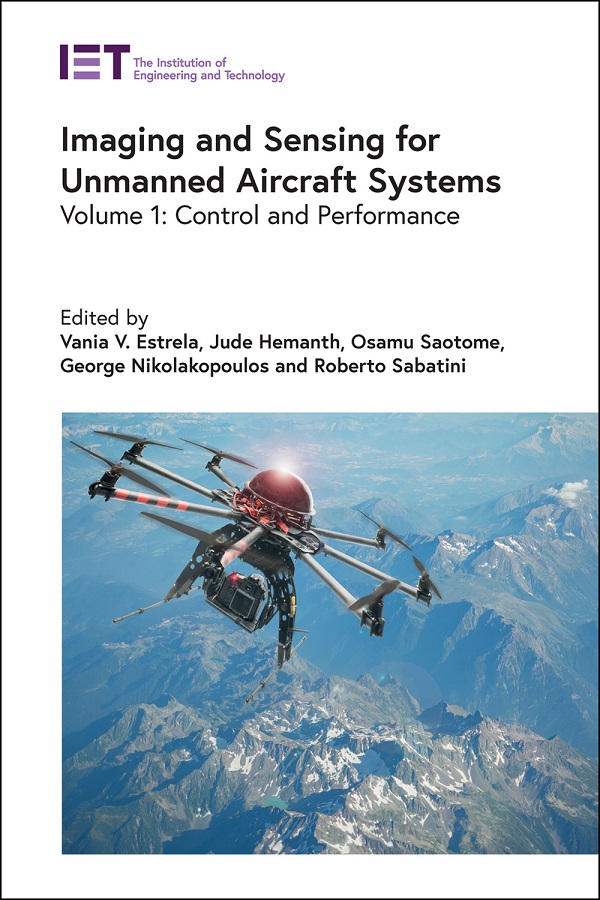- Agricultural Engineering and Technology
- Applied Physics
- Built Environment
- Computing and Networks
- Control, Robotics and Sensors
- Electrical Regulations
- Electromagnetics and Radar
- Energy Engineering
- Healthcare Technologies
- History and Management of Technology
- IET Codes and Guidance
- Manufacturing
- Materials, Circuits and Devices
- Model Forms
- Security
- Telecommunications
- Transportation

Imaging and Sensing for Unmanned Aircraft Systems
Volume 1: Control and Performance
Edited by Vania V. Estrela, Jude Hemanth, Osamu Saotome, George Nikolakopoulos, Roberto Sabatini
This two-volume book set explores how sensors and computer vision technologies are used for the navigation, control, stability, reliability, guidance, fault detection, self-maintenance, strategic re-planning and reconfiguration of unmanned aircraft systems (UAS).
Volume 1 concentrates on UAS control and performance methodologies including Computer Vision and Data Storage, Integrated Optical Flow for Detection and Avoidance Systems, Navigation and Intelligence, Modeling and Simulation, Multisensor Data Fusion, Vision in Micro-Aerial Vehicles (MAVs), Computer Vision in UAV using ROS, Security Aspects of UAV and Robot Operating System, Vision in Indoor and Outdoor Drones, Sensors and Computer Vision, and Small UAV for Persistent Surveillance.
Volume 2 focuses on UAS deployment and applications including UAV-CPSs as a Testbed for New Technologies and a Primer to Industry 5.0, Human-Machine Interface Design, Open Source Software (OSS) and Hardware (OSH), Image Transmission in MIMO-OSTBC System, Image Database, Communications Requirements, Video Streaming, and Communications Links, Multispectral vs Hyperspectral Imaging, Aerial Imaging and Reconstruction of Infrastructures, Deep Learning as an Alternative to Super Resolution Imaging, and Quality of Experience (QoE) and Quality of Service (QoS).
About the Editors
Vania Estrela is a faculty/researcher at Telecommunications Department, Universidade Federal Fluminense (UFF) and a visiting scholar at UNICAMP. Her research interests include biomedical engineering, electronic instrumentation, modelling/simulation, sustainable design, multimedia, artificial intelligence, remote sensing, STEM education, environment, and digital inclusion. She has served as a reviewer for IEEE, Elsevier, ACM, IET, Springer-Verlag, and MDPI. She has extensive experience as a project manager, post-graduate advisor (M.Sc. and D.Sc.), as well as an editor of books and special issues.
Jude Hemanth is an associate professor in the ECE Department of Karunya University (KU), India. He is a member of the IEEE task force on deep learning and serves as associate editor and editorial board member for several international refereed journals.
Osamu Saotome is a professor at the Instituto Tecnológico de Aeronáutica (ITA), Brazil. He has been involved in several international research and cooperation projects with the Brazilian Air Force, INPE, IEAv (France, Sweden, USA, and Japan).
George Nikolakopoulos is a professor in robotics and automation at the Department of Computer Science, Electrical and Space Engineering at Luleå University of Technology (LTU), Sweden. He is also a member of the ARTEMIS Scientific Council of the European Commission. He has significant experience in Managing European and National R&D&I projects funded by the EU, ESA, Swedish and the Greek National Ministry of Research.
Roberto Sabatini is a professor of aerospace engineering and aviation in the School of Engineering at RMIT University (Australia) specialising in Avionics and Intelligent/Autonomous Systems for Aerospace and Defence applications. Currently, he serves as Deputy Director (Aerospace) of the Sir Lawrence Wackett Centre and Chair of the Cyber-Physical Systems Group at RMIT University. Professor Sabatini is a Fellow and Executive Member of the Institution of Engineers Australia, Fellow of the Royal Aeronautical Society, and Fellow the Royal Institute of Navigation. Throughout his career, he led numerous industry and government-funded research projects and he has authored or co-authored over 250 peer-reviewed international publications. In addition to his primary faculty duties, Professor Sabatini serves as Vice-Chair of the IEEE-AESS Avionics Systems Panel and editor for several high-impact international journals.
Publication Year: 2020
Pages: 360
ISBN-13: 978-1-78561-642-6
Format: HBK
Editors: Vania V. Estrela, Jude Hemanth, Osamu Saotome, George Nikolakopoulos, Roberto Sabatini
